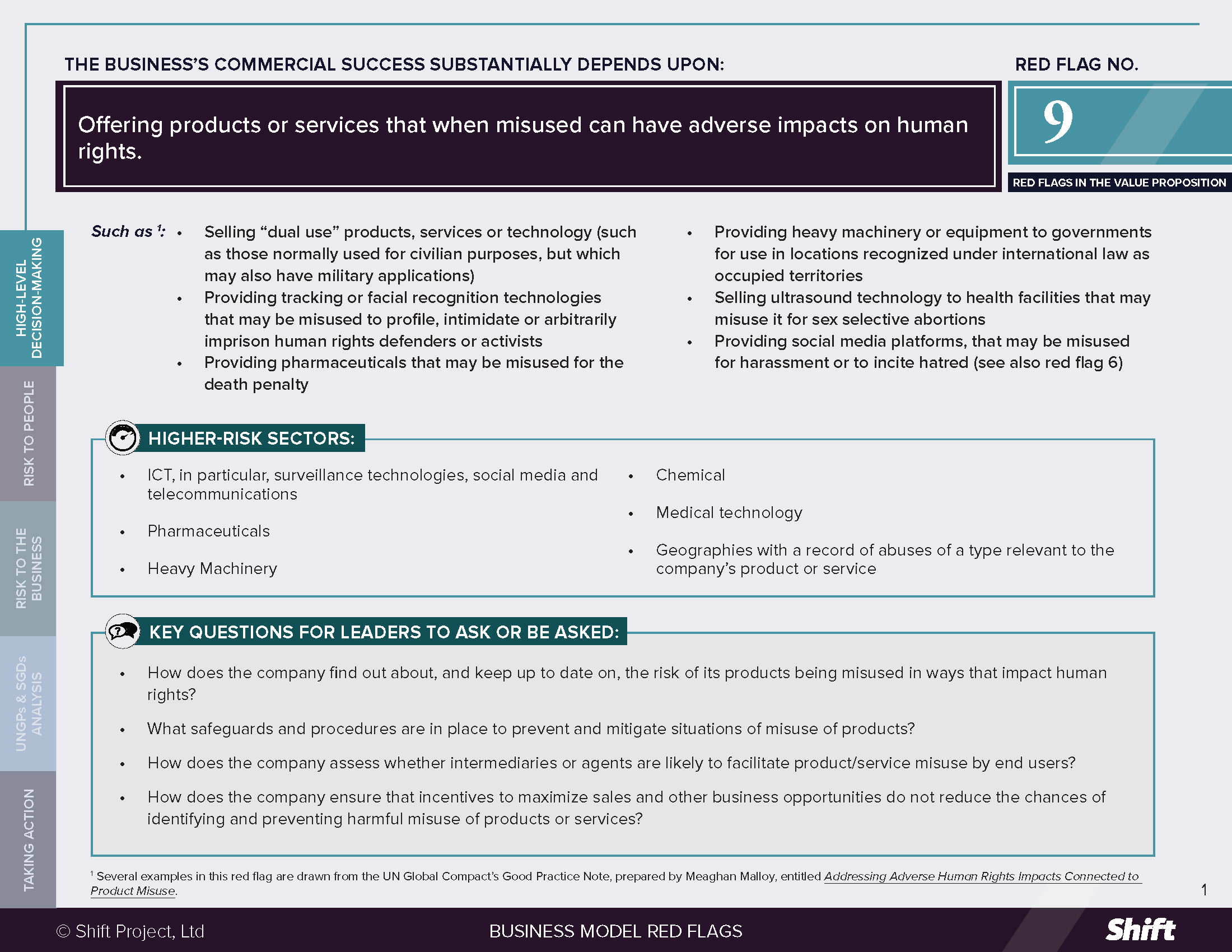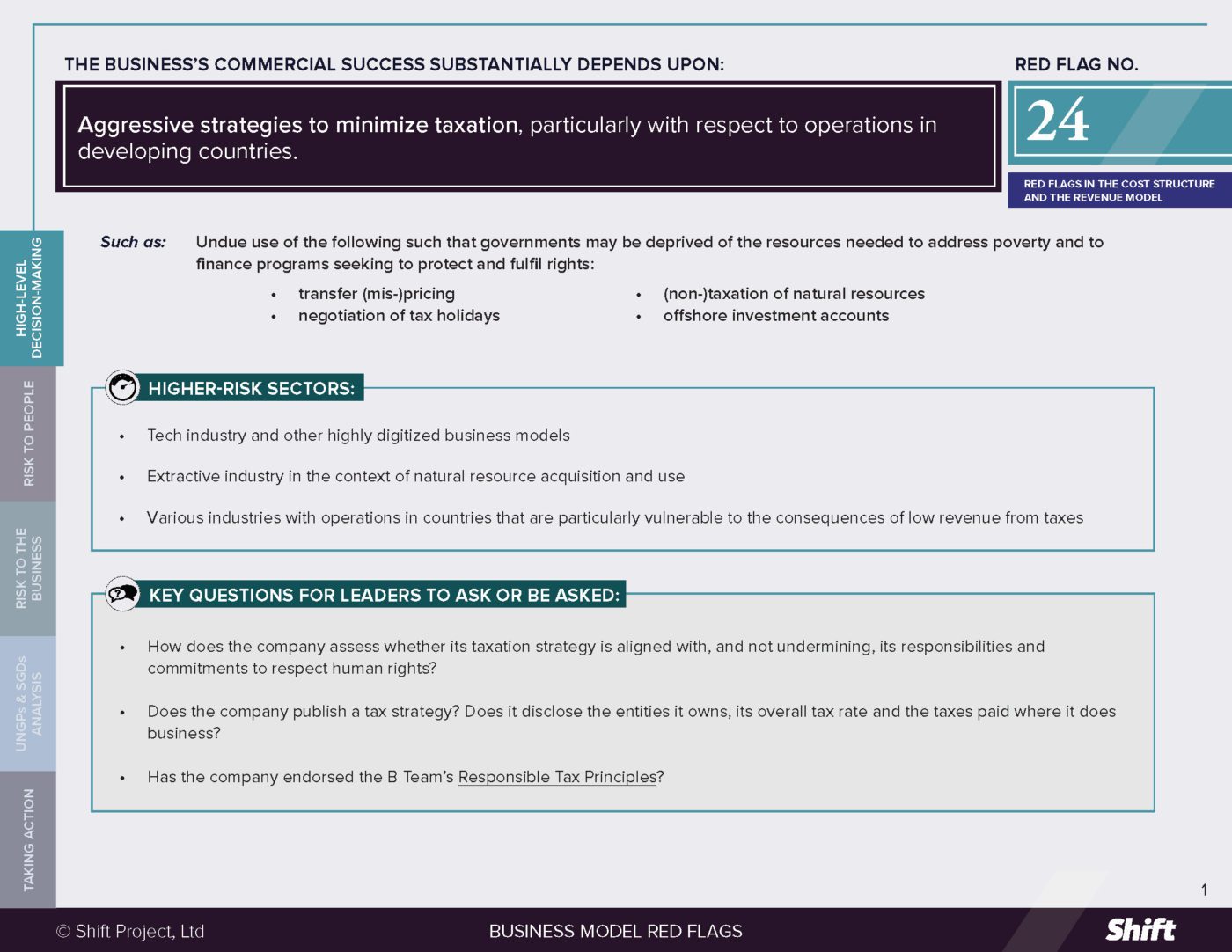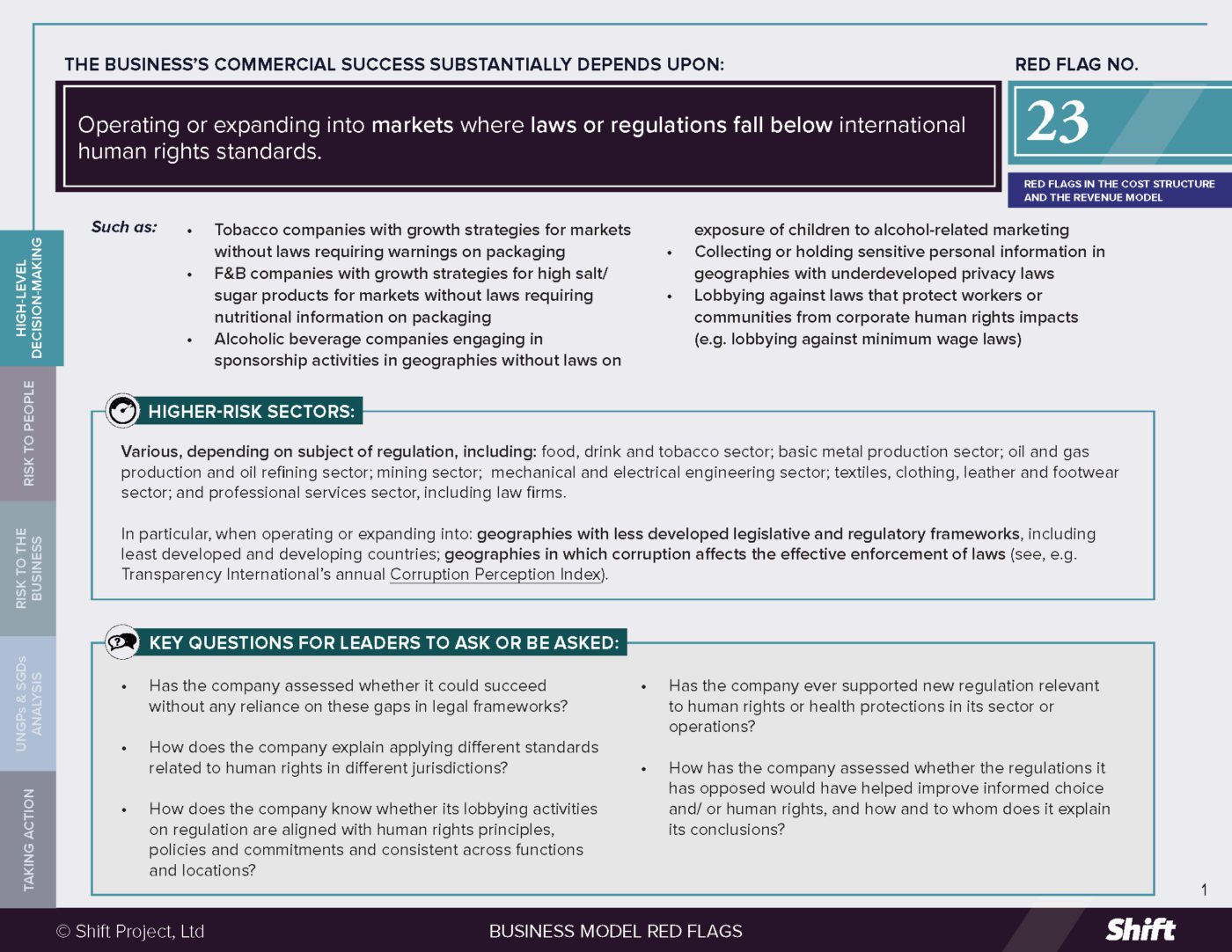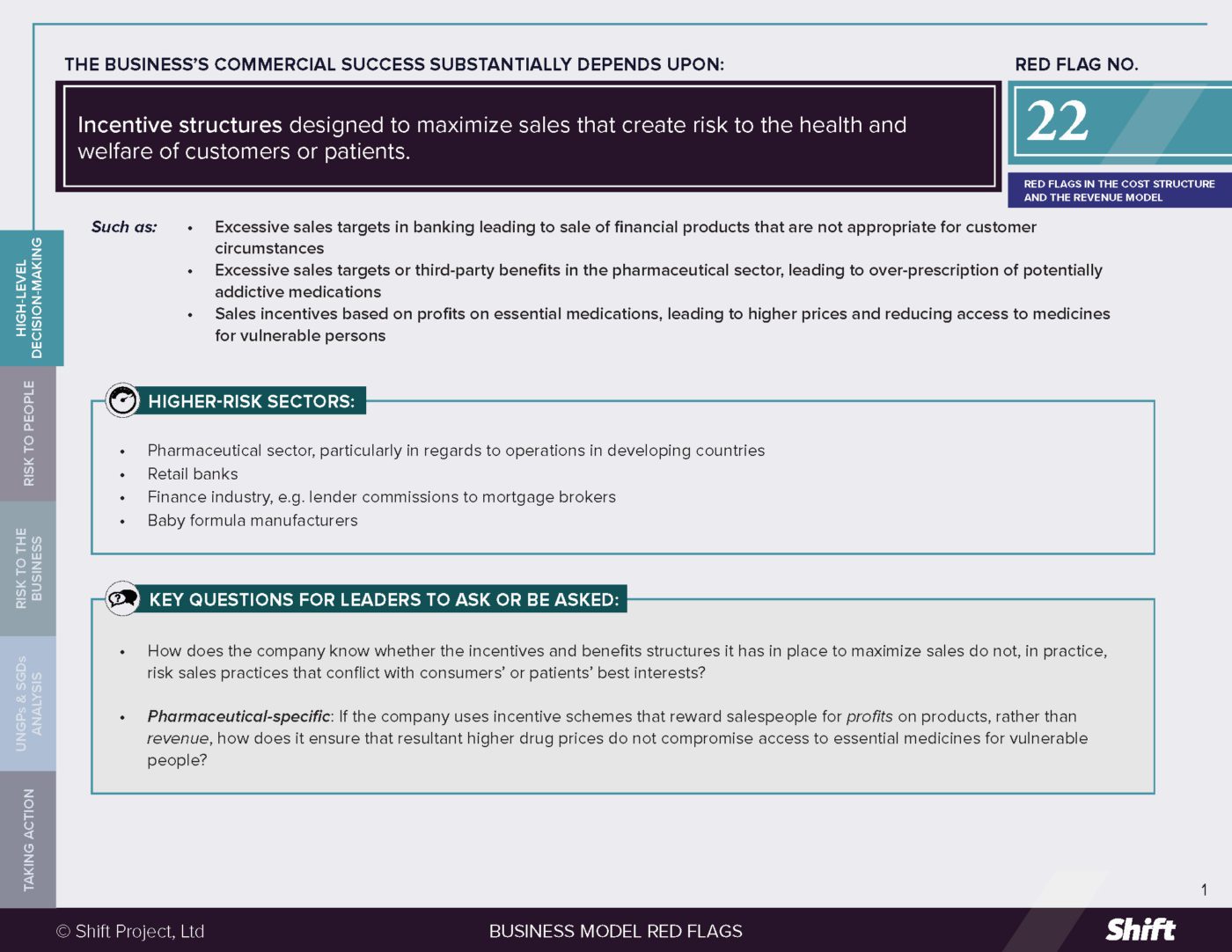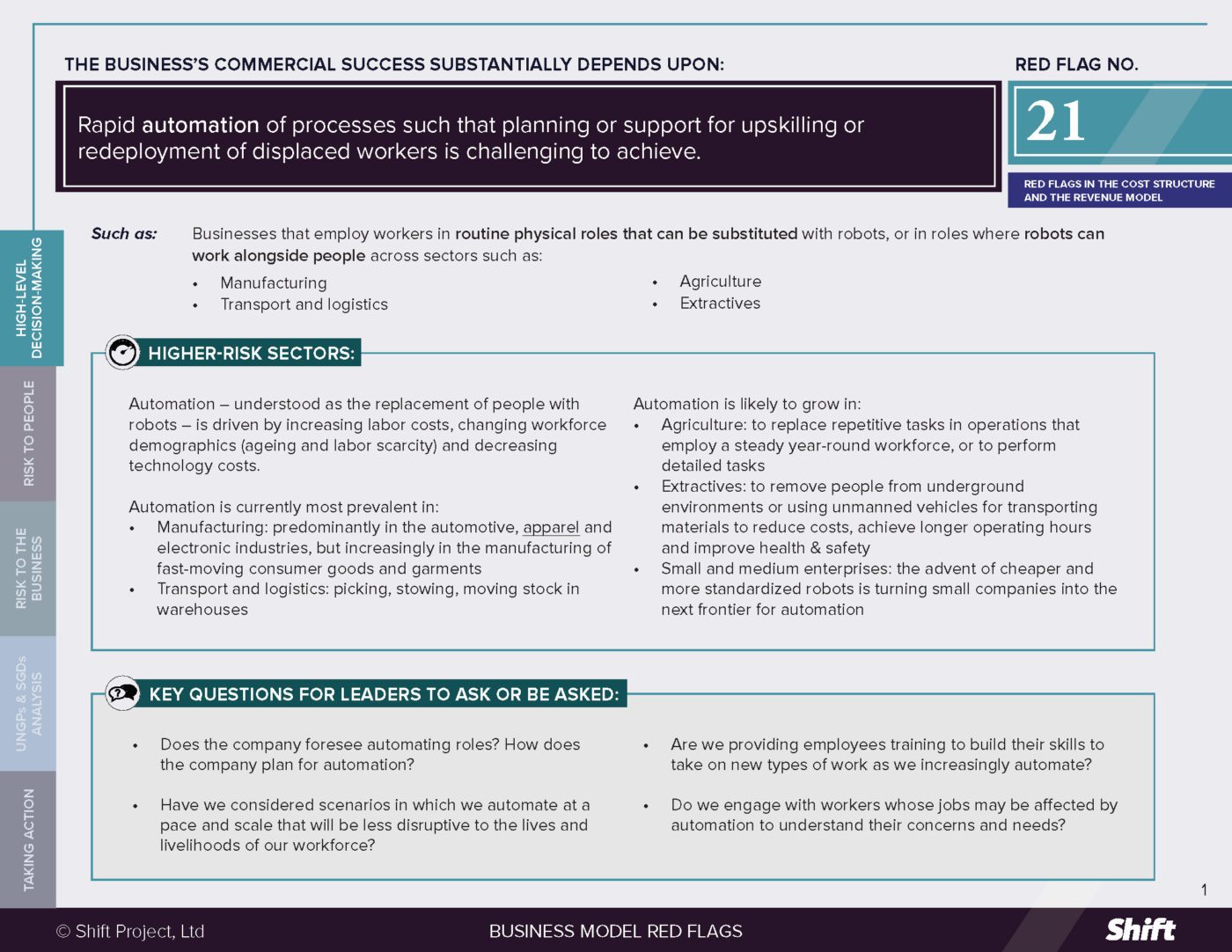RED FLAG # 9
Offering products or services that when misused can have adverse impacts on human rights.
For Example
(
Several examples in this Red Flag are drawn from the UN Global Compact’s Good Practice Note, prepared by Meaghan Malloy, entitled, Addressing Adverse Human Rights Impacts Connected to Product Misuse.
)
- Selling “dual use” products, services or technology (such as those normally used for civilian purposes, but which may also have military applications)
- Providing tracking or facial recognition technologies that may be misused to profile, intimidate or arbitrarily imprison human rights defenders or activists
- Providing pharmaceuticals that may be misused for the death penalty
- Providing heavy machinery or equipment to governments for use in locations recognized under international law as occupied territories
- Selling ultrasound technology to health facilities that may misuse it for sex selective abortions
- Providing social media platforms, that may be misused for harassment or to incite hatred (see also Red Flag 6)
Higher-Risk Sectors
- ICT, in particular, surveillance technologies, social media and telecommunications
- Pharmaceuticals
- Heavy Machinery
- Chemical
- Medical technology
- Geographies with a record of abuses of a type relevant to the company’s product or service
Questions for Leaders
- How does the company find out about, and keep up to date on, the risk of its products being misused in ways that impact human rights?
- What safeguards and procedures are in place to prevent and mitigate situations of misuse of products?
- How does the company assess whether intermediaries or agents are likely to facilitate product/service misuse by end users?
- How does the company ensure that incentives to maximize sales and other business opportunities do not reduce the chances of identifying and preventing harmful misuse of products or services?
How to use this resource. ( Click on the “+” sign to expand each section. You can use the side menu to return to the full list of red flags, download this Red Flag as a PDF or share this resource. )
Understanding Risks and Opportunities
Risks to People
- Risks to people are heightened by the nexus between products that are vulnerable to misuse and sales to entities likely to misuse them.
- Interviews with business and civil society representatives conducted by the UN Global Compact “underscored that one of the biggest challenges in conceptualizing product misuse as a human rights issue is the vast array of ways, including non-obvious ways, a product or service can be misused and inflict human rights harm.”
- Several examples are listed above and include severe impacts, such as:
- sale of pharmaceuticals misused for the administration of the death penalty (right to life; right to freedom from torture, cruel, inhuman or degrading treatment);
- sale of tracking or facial recognition technologies that may be misused to surveil civil society or arbitrarily imprison, e.g. ethnic or political groups. (Freedom from arbitrary arrest, detention or exile and/or freedom from torture and inhuman or degrading treatment).
Risks to the Business
- Reputational Risks: Links between well-known companies and the impacts of product misuse are more easily spread through the 24/7 news cycle and the sharing of incidents and photographs facilitated by mainstream and social media. During the Arab Spring, the role of Western Technology firms in “helping Arab dictators” was highlighted in US media. Popular opinion increasingly places some degree of responsibility on the companies concerned, and not just on those misusing the product or service, or on regulators.
- Financial Risks: These may include investor divestment or customer boycotts where companies are seen to be failing to address product misuse. In 2012, construction machinery company Caterpillar was removed from three MSCI indexes for factors including “an ongoing controversy associated with use of the company’s equipment in the occupied Palestinian territories.”
- Legal, Financial and Operational: Risks also arise, for example, where end users include repressive regimes. Blacklisting of Chinese technology companies by the US Government on the grounds of rights violations against Muslim minority groups in Xinjiang, China, disallows US companies from selling technology to these companies without a US government license. In 2019, Sony and Sharp faced scrutiny for the alleged supply of parts to a Chinese video surveillance company blacklisted by the United States over human rights violations of ethnic Uyghur people in the Xinjiang Autonomous Region of China. The blacklisted company had “previously stated on its website that it could identify members of the Uighur ethnic minority group.”
What the UN guiding principles say
*For an explanation of how companies can be involved in human rights impacts, and their related responsibilities, see here.
This red flag arises in two distinct situations, namely where the business relies on:
- sales to a known commercial customer where there is a likelihood it will misuse the product in ways that have human rights impacts, or sell it onwards to an end-user who misuses the product
- sale of a product or service to the general public, where there is recognized misuse by a minority.
With regards to scenario a), Guiding Principle 13(b) states that businesses should “seek to prevent or mitigate adverse human
rights impacts that are directly linked to their operations, products or services by their business relationships, even if they have not contributed to those impacts.” Business relationships include relationships with commercial customers, and as such, a company may be directly linked to an impact caused by commercial customers in the course of using the product or service.
In certain circumstances, product misuse by a commercial customer may involve a situation of contributing to harm where a company knows of the risk or fact of its products being misused, and does nothing to address the situation. The UN Global Compact describes a scenario in which a company sets up a shell company in order to hide the fact that it is selling surveillance technology to repressive governments. If the company knew or should have known that the governments concerned were likely to use the product to impact human rights, yet proceeded with a sale that enables this, it may be considered to contribute to any harm suffered.
In scenario b), the scope of the company’s human rights responsibility includes the safety of people using its products, even if they are not the intended user. As such, if the company is – or should be – aware of a potential negative impact associated with its products, a failure to adapt the product or otherwise seek to minimize the risk of the impacts occurring (e.g. through terms and conditions of use, warnings on packaging or instructions etc.) could place the company in a situation of causing an impact, or, where the impact on a third party is caused by a consumer misusing its products, contributing to the impact.
Possible contributions to the SDGs
Addressing impacts to people associated with this red flag indicator can contribute to a range of SDGs depending on the industry and impact concerned, for example:
SDG 3: Good Health and Well-Being.
SDG 9: Industry, innovation and infrastructure, in particular Target 9.1: Develop quality, reliable, sustainable and resilient infrastructure, including regional and transborder infrastructure, to support economic development and human well-being, with a focus on affordable and equitable access for all.
SDG 10: Reduced Inequalities, in particular Target 10.2: By 2030, empower and promote the social, economic and political inclusion of all, irrespective of age, sex, disability, race, ethnicity, origin, religion or economic or other status.
SDG 11: Sustainable Cities and Communities, in particular Target 11.3: By 2030, enhance inclusive and sustainable urbanization and capacity for participatory, integrated and sustainable human settlement planning and management in all countries.
SDG 12: Responsible Consumption and Production.
SDG 16: Peace, Justice and Strong Institutions, in particular Target 16.1: Significantly reduce all forms of violence and related death rates everywhere. Target 16.6: Develop effective, accountable and transparent institutions at all levels. Target 16.7: Ensure responsive, inclusive, participatory and representative decision-making at all levels.
Taking Action
Due Diligence Lines of Inquiry
- How do we assess the potential risk of product misuse? How do we understand and address the ways in which “specific variables in design, components or materials used, and markets and customers targeted” may lead to product misuse resulting in human rights impacts?
- How do we know which of our end users/customers are high risk from a product misuse perspective? How do we stay abreast of developments that affect the level of risk? What systems do we have in place to identify and address such risks, prior to sale? Has the company considered how it might work with others – regulators, industry peers, customers, civil society organizations etc. – to seek ways to minimize the potential misuse of its products?
- Do we build safeguards against product misuse into our agreements with business customers, end-users and intermediaries involved in the sale of our products/services? Have we considered how we could use contract clauses or service provisions to monitor usage?
- How do we track and report internally or externally on our efforts to ensure responsible use of our products and/or services?
Mitigation Examples
* Mitigation examples are current or historical examples for reference, but do not offer insight into their relative maturity or effectiveness.
- Where the red flag relates to sales to a known commercial customer where there is a likelihood they will misuse it in ways that have human rights impacts, mitigation has involved attempting to influence their use of the product or limiting sales to that customer:
- Misuse of Pharmaceutical Drugs for the Death Penalty: Drug companies have adopted controls on the distribution of their products to ensure that none are used in lethal injections. In 2016 Pfizer announced that it will restrict the sale of relevant drugs to selected wholesalers who must certify that they will not resell the drugs to corrections departments in the United States. Following Pfizer’s announcement it was reported that all Food and Drug Administration-approved manufacturers of any potential execution drugs have blocked their sale for the purpose of lethal injection.
- Misuse of Ultrasound Technology in Sex-selective Abortions: GE discovered that its portable ultrasound machines, which enable access to life-saving medical treatment in remote regions, were being used by some facilities in India, in contravention of local law, to determine the sex of fetuses to enable early abortion of those that are female. This reflected strong social preferences for male children in India. In response, the company strengthened training to sales agents, added an explicit warning about national legal requirements in all sales contracts and on the machines themselves, engaged with NGOs and other local stakeholders, pushed for industry-wide collaboration and collaborated in a public education campaign on women and girls’ rights.
- Where the red flag relates to the sale of a product or service to the general public and where there is recognized misuse by a minority of users, mitigation examples have involved adapting the product to protect the wider public against that potential misuse.
- In Japan, telecoms companies offering phones with cameras have long requested that manufacturers disable the ability to mute the camera shutter sound when a photo is taken. This is done to ensure that users cannot covertly take sexually intrusive pictures of others.
- Industrial manufacturer Honeywell International found a way to make a safer alternative to ammonium nitrate that was designed to be hard to ignite, after the fertilizer was used in a bomb that killed 168 people in Oklahoma.
Other tools and Resources
- UN Global Compact Good Practice Note, prepared by Meaghan Malloy (2017) Addressing Adverse Human Rights Impacts Connected to Product Misuse.
- Human Rights and Business Dilemmas Forum, Product Misuse dilemma sets out common product misuse scenarios, case examples, risks to business and suggestions for responsible business.
- Bureau of Democracy, Human Rights, and Labor, U.S. Department of State Guidance on Implementing the “UN Guiding Principles” for Transactions Linked to Foreign Government End-Users for Products or Services with Surveillance Capabilities.

 Business Model Red Flags
Business Model Red Flags  Tool for Indicator Design
Tool for Indicator Design 